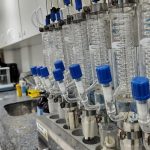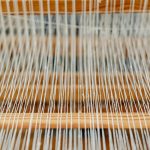You start with crude oil, drilling deep to extract it, then refining it to get naphtha. This naphtha undergoes chemical reactions to create nylon building blocks like adipic acid and hexamethylenediamine. These react in polymerization to form long polyamide chains. Next, the molten polymer is spun into fibers, cooled, and stretched for strength. Finally, the fibers are dyed and finished into textiles used in clothing. Keep exploring, and you’ll uncover the detailed steps behind each stage.
Table of Contents
Key Takeaways
- Crude oil is extracted and refined to obtain naphtha, the essential hydrocarbon for nylon precursor production.
- Chemical processes convert naphtha into nylon precursors like cyclohexane, adipic acid, and hexamethylenediamine.
- Polymerization links nylon precursors through condensation to form long polyamide chains with controlled molecular weight.
- Molten polyamide is spun into fibers by extrusion, cooling, and stretching to enhance strength and elasticity.
- Fibers undergo finishing, dyeing, and texturizing to produce durable, colorful, and functional textile fabrics for clothing.
Extraction and Refining of Crude Oil
The process of making polyamide begins with extracting crude oil, a crucial raw material.
Polyamide production starts with extracting crude oil, the essential raw material for the process.
When you drill deep into the Earth’s surface, you tap into reservoirs of this thick, complex mixture. Once extracted, the crude oil undergoes refining, where it’s heated and separated into various components by boiling points through distillation.
Lighter fractions, such as naphtha, are collected because they contain the hydrocarbons needed for producing polyamide. During refining, impurities like sulfur and metals are removed to guarantee purity.
This refined naphtha then serves as the feedstock for the chemical reactions that eventually lead to polyamide. You can see how critical this initial extraction and refining step is—it lays the foundation for everything that follows in making high-quality polyamide materials.
Production of Nylon Precursors
Once you have the refined naphtha, chemists transform it into key nylon precursors through a series of chemical reactions. This step is essential because these precursors serve as the building blocks for nylon production.
You’ll see how simple hydrocarbons evolve into more complex molecules ready for polymerization.
Here’s what happens next:
- Catalytic cracking breaks down hydrocarbons into smaller units.
- Cyclohexane is synthesized as a backbone for nylon 6,6.
- Adipic acid is produced through oxidation of cyclohexanol.
- Hexamethylenediamine is formed via the hydrogenation of adiponitrile.
- Caprolactam is created by converting cyclohexanone oxime.
Polymerization Process to Create Polyamide
Although you’ve prepared the essential nylon precursors, you still need to link them together through polymerization to form polyamide chains. This process usually involves a condensation reaction between diamines and dicarboxylic acids or their derivatives.
When these molecules combine, they release small byproducts like water or hydrogen chloride, which you remove to push the reaction forward. You carefully control the temperature and pressure to optimize chain length and molecular weight, ensuring the resulting polyamide has the desired strength and flexibility.
As the reaction proceeds, monomers repeatedly connect, creating long, repeating units that define polyamide’s structure. By managing reaction conditions and catalyst presence, you influence the polymer’s properties, setting the stage for its transformation into fibers later on.
This step is vital for turning raw chemicals into functional polyamide material.
Spinning Polyamide Fibers
After polymerization creates long polyamide chains, you need to shape them into usable fibers. This step, called spinning, transforms the molten polymer into fine filaments ready for textiles.
Here’s how you do it:
- Melt the polyamide pellets into a viscous liquid.
- Extrude the molten polymer through a spinneret with tiny holes.
- Cool the extruded filaments rapidly to solidify them.
- Stretch the fibers to align molecules, increasing strength and elasticity.
- Wind the continuous filaments onto spools for further processing.
This spinning process is essential because it determines the fiber’s properties like thickness, durability, and texture.
Finishing and Textile Manufacturing
When you have your polyamide fibers ready, finishing and textile manufacturing shape them into the final products you use every day. These steps include dyeing, texturizing, weaving or knitting, and applying chemical finishes to enhance durability, softness, and water resistance. You’ll find polyamide in everything from activewear to carpets due to its versatility.
Here’s a quick look at key finishing techniques and their effects:
| Finishing Technique | Purpose | Result |
|---|---|---|
| Dyeing | Adds color | Vibrant, lasting hues |
| Texturizing | Creates texture | Elastic, soft fabric |
| Heat Setting | Stabilizes shape | Wrinkle resistance |
| Chemical Finishes | Adds functionality | Water repellent, anti-static |
These processes guarantee polyamide fabrics meet your performance and aesthetic needs.
Frequently Asked Questions
What Environmental Impacts Result From Polyamide Production?
You might feel like you’re in Pandora’s box when you consider polyamide production’s environmental impact—it releases greenhouse gases, consumes lots of energy, and causes pollution. You can help by choosing sustainable alternatives and supporting greener practices.
How Durable Is Polyamide Compared to Other Synthetic Fibers?
You’ll find polyamide highly durable—it resists abrasion and stretching better than many synthetics like polyester. It’s strong yet lightweight, making it ideal for activewear and outdoor gear that need to withstand tough conditions.
Can Polyamide Fibers Be Recycled or Reused?
You can recycle polyamide fibers, but it’s not always straightforward. Mechanical and chemical recycling methods exist, allowing you to reuse them in new products. However, availability and quality of recycled polyamide might vary depending on the process.
Are There Any Health Risks Associated With Wearing Polyamide Clothing?
You might experience skin irritation or allergies wearing polyamide clothing if you have sensitive skin. However, most people don’t face health risks, and it’s generally safe to wear polyamide fabrics daily without issues.
What Are the Common Uses of Polyamide Beyond Textiles?
Think of polyamide as a versatile superhero—it doesn’t just dress you, it strengthens car parts, crafts fishing lines, and builds industrial gears. You’ll find it everywhere, making everyday things tougher and more reliable.
- Does Chiffon Fabric Stink - July 15, 2025
- Does Chiffon Fabric Affect the Economy - July 15, 2025
- Does Cotton Fabric Have a Nap - July 15, 2025







